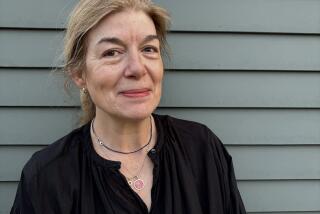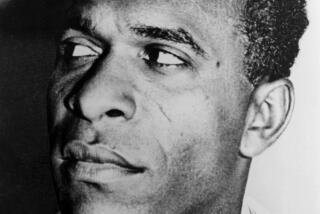Review: Graphic memoir ‘Arab of the Future’ takes a look back to the author’s childhood in Libya and Syria
The French cartoonist Riad Sattouf spent the earliest years of his life in three dictatorships. One dictator was Col. Moammar Kadafi, the “supreme leader” of Libya, where Sattouf and his parents moved when he was 2. Another was President Hafez Assad of Syria, where they relocated when he was 4. And the most important one, as far as he was concerned, was his father, a Syrian-born professor who’d met Sattouf’s mother while they were studying at the Sorbonne in Paris and who had cast his son in his dreams of a pan-Arabist utopia before Riad had even been born.
“The Arab of the Future” is Sattouf’s graphic memoir of that childhood; it’s engaging and lovely to look at, and he milks the disjunction between how he experienced his political environment at the time and how he understands it now for all it’s worth. (That’s fortunate because his young self barely speaks or acts in the book: He’s an adorable blond moppet to whom everything happens.) When his family arrives in Libya, they’re informed that Kadafi has abolished private property, so the door of their house doesn’t lock from the outside, and shortly thereafter, as they come back from taking a walk, they find that someone else has moved in. Displacement and food lines that yield little more than bananas or eggs for weeks on end don’t faze young Riad, though. “Back then, I didn’t understand very much,” he writes. “But I was sure of one thing: my father was fantastic.”
SIGN UP for the free Essential Arts & Culture newsletter >>
It’s Sattouf’s father who always hovers just outside the focal point of this story: a big dreamer who rattles on about modernizing and uniting the Arab world but is prone to casual bigotry, who dreams of constructing a “luxury villa” but rhapsodizes about the privations of his poverty-stricken youth. In one remarkable scene, he tells Riad about an incident from his school days, when he and a friend were told they were going to be publicly executed for stealing a Syrian flag, “but in fact they just fetched a stick and hit us with it so hard that we couldn’t sit down for the next week”; as he recounts the story, he can’t stop laughing. His reaction to encountering an actual public hanging with his family a bit later: “That’s life.”
From the vantage point of the present — Sattouf lives in Paris, has made several films and was a columnist for Charlie Hebdo — he paints the Arab states of his youth as grossly barbaric, even on a child’s scale. On his arrival in Syria, other kids immediately accuse him of being “yahudi” (a Jew) and start pummeling him. The climax of this volume is a blackly over-the-top scene in which young Riad is sick but his father can’t find medication anywhere in their city; meanwhile, children outside in the street are torturing and killing a puppy, and to top it all off, his infant brother is eating roach eggs. But the book isn’t all overstatement, and Sattouf also has an eye for grimly funny details, like the plastic soldiers he and his cousins played with in Syria (the Syrian soldiers hold Kalashnikovs and strike heroic poses; an Israeli soldier waves a flag of surrender while concealing a dagger behind his back).
Had Marjane Satrapi’s “Persepolis” not become a hit and encouraged English-language publishers to populate the understocked “graphic memoirs of cross-cultural childhood” shelves, it would be somewhat less likely that Sattouf’s book would have found a major publisher in the U.S. “The Arab of the Future” may look comfortingly familiar to fans of “Persepolis” too: Sattouf’s clean-lined caricatures are a cousin to Satrapi’s, particularly the way he draws the clusters of women in his father’s hometown. Solid expanses of a single color at a time do most of the work of accenting his black-and-white linework — respectively blue, yellow and red for the sections set in France, Libya and Syria.
Other cartoonist/memoirists of Sattouf’s cohort, like David B. and Satrapi, often give their autobiographical work some subtext about how they became artists, which Sattouf wittily resists. We see him praised at a very early age for his “very advanced” drawings of Georges Pompidou; then, in kindergarten during a brief sojourn in France, he abandons that skill and learns to “draw” the way other kids do, by holding a crayon in his fist and cursing (“It was amazingly enjoyable to draw meaningless scribble”).
Still, this isn’t the end of Sattouf’s story, and we may yet see his interior life develop. “The Arab of the Future” is distinctly the first volume of a trilogy (the second volume has already been published in France). It ends with another change in the family’s circumstances and a “to be continued.” As it stands, it’s a memoir about the early experiences Sattouf has put behind himself more than it is about the ones that shaped him.
Wolk is the author of “Reading Comics: How Graphic Novels Work and What They Mean.”
::
The Arab of the Future
A Childhood in the Middle East, 1978-1984
Riad Sattouf
Metropolitan Books, 160 pp., $26.00
More to Read
The biggest entertainment stories
Get our big stories about Hollywood, film, television, music, arts, culture and more right in your inbox as soon as they publish.
You may occasionally receive promotional content from the Los Angeles Times.










